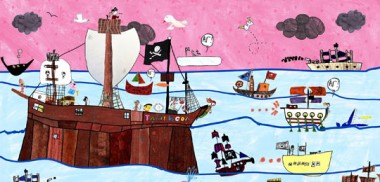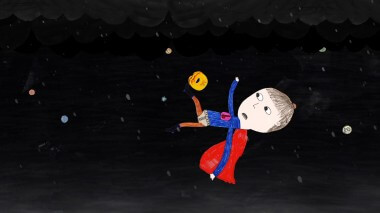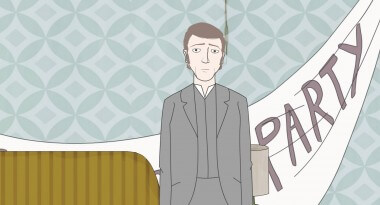Producing Animation: Sarah Cox (Arthur Cox) Interview
Children, like animals, are forever being branded as something you should never work with. But then the fabulous film The Itch of the Golden Nit came along, and proved that children could in fact be trusted collaborators, and perfect allies for animation. Because not only did the film, which boasts a collaboration of 34,000 children, reveal their ability to create imaginative, larger-than-life characters, it also showed their aptitude for hugely refreshing, creative and hilarious storylines.
A bit about Sarah…
Sarah Cox, the film’s director, recognised children’s ability to work with animation some time ago. After studying for an animation degree at Liverpool, she began working with the community film collective ‘Open Eye’, running animation workshops with children in deprived areas of Liverpool. She then moved on to the Royal College of Art and, a year after graduating, completed the film 3 Ways to Go, which was commissioned as part of the ANIMATE! Scheme and won Best Film under 10 Minutes at the British Animation Awards.
Since then Sarah combined her love of animation with teaching, working as a lecturer at Humberside University, then The National Film and Television School and as Head of Animation at Savannah College for Art and Design, in Georgia, USA.
Throughout her time lecturing she also managed to maintain her career as a commercial director in animation; creating MTV idents and music promos with John Parry, before joining Picasso Pictures in 1994. Here, she began directing huge campaigns for Boots No7 and Avaya Communications, as well as commercials for big name brands such as Sanatogen and Virgin Megastores.
Sarah has also continued to receive a great deal of success and recognition for her short films; Plain Pleasures won Silver Dove at DOK Leipzig in 2001, while Heavy Pockets was nominated the Short Animation BAFTA and won Best Animation at Savannah Film Festival 2005. Her first stop motion film Don’t Let it All Unravel, was made in conjunction with Aardman Animations as one of the 60 environmental films commissioned for the ‘Live Earth’ concerts and has since won 11 international film awards and has been screened at numerous festivals.
In 2002, Sarah left Picasso Pictures and set up her own production and animation company Arthur Cox, with Sally Arthur and has since directed several commercials in France and has been increasingly involved as a producer on many film projects. These include Emma Lazenby‘s BAFTA award winning film, Mother of Many, and the forthcoming live action film, iFeature’s Eight Minutes Idle.
Arthur Cox continues to develop and expand, often working closely with Aardman Animations, as seen with the road safety series The Peculiar Adventures of Hector, which won a British Animation Award in 2007, and the more recent The Itch of the Golden Nit, 2011.
We caught up with Sarah to learn a bit more her and her role in Arthur Cox, as well as discover more about the process of working with children to create the fantastic film, The Itch of the Golden Nit.
Interview
You studied for an MA in Animation at the Royal College of Art which is renowned for turning out successful animators. What do you think it is about this institution that keeps producing such great talent?
I went a long time ago when Dick Taylor was still there so it was quite a different RCA. We were basically a room full of eager animators from all different backgrounds. Over the 2 years I was there with Ruth Lingford, Run Wrake, Stuart Hilton, Phil Hunt, Jason Stalman, An Vrombraut, Luis Cook amongst many talented others, – so we learnt from each other. We also had some great visiting tutors; Yuri Norstein, Rolf Harris, Simon Pummel and Oliver Postgate. Just writing this makes me realise how lucky I was… We were next door to the life drawing room and I spent a lot of time in there. So I think the reason is just simply being in a conducive environment with like minded people and inspirational figures steering occasionally will produce good work… not necessarliy immediately. My college film was just an experiment really – my real film came a year later when I got an Animate commission – 3 Ways To Go – its the film that should have been my graduation film – but I was too busy learning and experimenting at RCA.
In a lot of your work, such as Heavy Pocket and Plain Pleasures you incorporate live action with different forms of animation to create a unique and almost experimental style. What do you think inspired this, and what do you like about this combination?
The reason for doing this was to obtain subtlety in the characters and their relationships – in their facial expressions and movements – I just don’t think I could do that with drawings. Some people can but not me.
I also love working with actors and seeing what they can bring to a film – I particularly liked working with the children in Heavy Pockets – they were fantastic. We didn’t script anything but did workshop sessions around the theme of bullying and how that can affect them. I would have liked to have made a longer film and developed some of the characters a little more.
I never thought I would move into Live Action though but now, producing Ifeatures film (8 minutes idle) I have: again its a desire to tackle a complexity and length of narrative that would be too expensive to do as animation.
Throughout your career in animation you have balanced working as a commercial director with directing your own short films. Do you feel you are able to have creative freedom in your commercial work or do you find that it always comes with a compromise?
Ha – well surprisingly sometimes I think I get more creative freedom in commercial projects than with the films. You are never entirely free if someone is funding you, but certainly with Tate all the direction came from the kids not from the top- whereas when we made 8 minutes idle we had 4 or 5 executive producers to convince at every stage. With TV commercials I learnt a long time ago that its really not about ‘creative freedom’ – you are helping your client sell a product and you can offer your best advice to help them create a fantastic and memorable commercial – if you expect to have total creative freedom you will always be disappointed. Anyway I like to have something to rail against.
Moving on to the fantastic film The Itch of the Golden Nit. What led you to take on such an ambitious project which allowed children to take the reigns?
I was directing commercials with Aardman and Heather Wright showed me a script that was intended for children to animate – the idea initially came from Rich Flintham and Matt Keon at Fallon and I was delighted to be asked to think about an approach. It gradually became more about the children writing the story and music and designing everything – the scale of this then necessarily led to the development of the website and all the workshops and everything – so it became much more ambitious as it went along. The whole process took about 6 years from initial conception to finished film so my involvement and the ambition of the project was a gradually increasing thing.
The Itch of the Golden Nit allowed children to contribute to all aspects of the film, as they drew the main characters and backgrounds as well as contributing to the dialogue and the music.
How do you think animation can benefit from allowing children to be content collaborators?
I think the days of children passively consuming content is over – children with access to computers have grown up with interactivity as a norm – they expect to have an input into their entertainment and in many respects they are way ahead of most content creators on this. The content was not surprising in itself; superheroes, pirates, aliens etc but the complexity of ideas was much more sophisticated than a lot of the animation targeted at their age groups. The obvious thing too is children are much better at deciding what they want to watch than a bunch of well meaning adults – they do need us grown ups a little bit, to refine and produce their ideas and to craft the humour and structure the narrative – but I would say on creative imagination they win hands down.
The film followed a unique production process. For those who don’t know could you explain a little bit how about the project came together?
Our mission was to create a half hour film that every child in the UK could be involved in if they wanted to. so to fulfil that mission we had to build a structure to fit. It was only as we started having the initial meetings did the scale of what we were trying to do really hit home – but everyone at Aardman was brilliantly supportive. Together with Dan Efergan from Aardman Digital we built an amazing website which acted as a flexible storage, tagging, and community hub for the children. Every week I would post story questions, and together with Lucy Murphy (script editor) we would select a pile of amazing ideas to give to the writer Dave Ingham – he would draft a script weaving together these ideas but leaving ‘managed holes’ for us to fill – this would prompt the next set of questions on the website. We developed a ‘story tree’ so that we could ask more structural questions first – question 1 for instance was ‘Who are the Good Guys?’, we then asked for a villain, a location, a motive – all following quite classical narrative structure.
The drawings submitted went through a similar process and every week myself and Emma Lazenby (Art Director) would feature a selection of drawings and sounds in a Voting Gallery and the kids would vote on their favorites – every vote winner HAD to go in the film. The same with the sounds submitted and much of the dialogue that came in went straight into the film completely unchanged.
The music too – many of the songs ( which are my favorite scenes) came directly from the website – children would just sing into the mic. John Browne ( composer) would then take these and orchestrate them so we had the full joy of Vic Reeves singing the ‘Hairy Pirate Song’ with the folk band The Young Un’s and local young folk musicians from the Gateshead are but the song was pretty much exactly as it was submitted on the website.
The ideas, drawings and sounds were uploaded by individuals and also the huge tour of workshops that toured the country so we were literally swamped by brilliance. The whole complex project was held together by the amazingly organised Helen Argo ( producer) and Heather Wright ( exec producer).
The Tate Galleries were heavily involved in the film, what influence did they have on the project?
The Tate was the perfect partner for the project ( along with CBBC of course) because they gave the whole thing a really strong environment. The workshops were framed in the context of looking at art works and they had a massive influence and what the children drew and wrote. Much of the initial story came from a workshop in Tate Liverpool where we showed the children Picasso’s Weeping Woman ( which was there as part of the Picasso Peace and Freedom exhibition), we asked why they thought she was crying and within the context of a script workshop – where they shouted out ideas, developing on each other thoughts; we got an amazing story chain about a girl called Diana whose hair grew 5 meters every 5 seconds, it grew so fast she had to wash it in the Mersey, one day a dead kitten fell out, her only friends were the nits that lived in her hair etc etc…quite dark but quite brilliant material. The main thing I learnt from the project was that children really soak up the visual world around them so it is very very important to expose them to good design early on… even if they don’t speak about it – it definitely has a massive effect we could see it clearly in the drawings.
Jane Burton at the Tate gave us and the children so much freedom that the creativity was allowed full reign. She also supplied us with a fully equipped Tate Truck that was kitted out with a sound studio, computers and art materials that t toured the country from the Orkneys to Land’s end. It was run by a marvellous team of Tate Movie Project Crew we were very lucky to have Stefan Georgiou leading the workshops – he and his huge team infused the project with such enthusiasm and the children were entranced by him. It made the whole experience for the children really special.
The Itch of the Golden Nit has been a huge success. Are you considering making another film collaborating with children in this way?
I would love to but the opportunity I had was a kind of perfect storm that doesn’t come along very often.The cultural Olympiad funding, the Tate’s support and Aardman asking me to be involved. It would be difficult ( but not impossible ) to do something on the same scale. I do have loads of ideas about how we could develop the idea though – doing a live action approach, or a series or a feature and we are looking at ways to develop the concept.
You have moved into more of a producer role since setting up your own production company, Arthur Cox, producing successful films such as Matthew Walker’s John and Karen. How involved are you in the production stages of the animation with this role and what do you enjoy about this position?
At ArthurCox I began producing purely out of necessity because I couldn’t afford to pay a full time producer. What I really love about the role is developing talent and pushing that talent out there so it can get noticed. we used to spend an awful lot of time sending films out to animation festivals and by doing that we built a much bigger reputation than we otherwise would have had. It was an immense step to then producing 8 minutes Idle ( an iFeatures micro budget live action feature) I learnt so much doing that and I am eager to put all that learning back into practice. It was a great experience working with Mark Simon Hewis ( the director) and we are keen to work together again. Strangely he works in production too so we had a very good understanding of each others roles; I’m hoping he will be the producer next time.
Lastly, what can we look forward to seeing from Sarah Cox/Arthur Cox in the future? Can you give tell us anything about Arthur Cox’s involvement with the upcoming adaptation of Graham Chapman’s A Liar’s Biography?
Oh gosh – I have lots of things I would like to do … something that takes what we did on Itch of the Golden Nit but develops it would be great – I also have an idea for a comedy/archive/retro documentary – I also wouldn’t mind a few months off. For the time being though I have just directed a short for the Humane Society of the United States to raise awareness to kids about intensive pig farming. Its my first plasticene film.
The Chapman film all happened whilst I was finishing off 8 minutes idle – so that was produced by Kaia Rose for ArthurCox – we had 4 sections to animate – and I think we got some great scenes; the ‘Coming out’ scene which is very funny and directed by Matthew Walker, he also got to do the ‘getting pissed’ scene where Graham is so pissed he has sex with a lady from the hotel lobby. Then George Sanders Jackson did the ‘drying out’ scene which was done with painting on glass. We think its the first ever 3D painting on glass animation. This scene strikes a powerful emotional chord within the comedy of the film.





